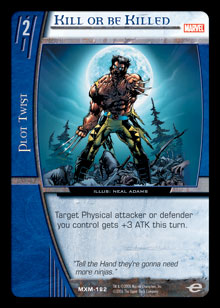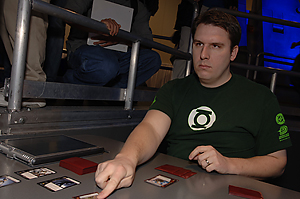
Pro Circuit Atlanta has come and gone, and we are now left to look to the future. There are only three months before the next PC, and there’s plenty of work to be done. A new set will soon be out, which means plenty of work ahead for those of you looking to break the brand-new Silver Age format. As unfortunately ignorant as I am to breaking a Constructed format, I tend to look in another direction when a new set releases. I have three short months to get a good grasp on The X-Men. Share in my tale.
The last time I broke down a set, it took a little more space than I would have liked, but that’s the way it goes. Sets aren’t small and they require an adequate amount of attention. I made my share of mistakes along the way, as well, and I’m thankful to those of you who wrote me to show me the error of my ways.
I got to thinking about how I was going to tackle The X-Men this time around. With JLA, I tended to list cards and give my opinions of them. While this told you what I thought of a card and got you headed in the right direction, it did little to get you to see why I thought that way. I decided that something needed to change.
This time around, I have a much better idea. I want to combine all of the strategy articles I’ve written on Draft and Sealed Pack along with a discussion on the cards in the set. The trouble is that I need a way to do this without being too dry. It took me a while to figure out a solution, but my experiences at the Pro Circuit made me realize something—I was doing that every time I covered a draft.
I want to treat my next article series as if I were covering a draft at the PC. I will tell you the cards in my packs. This will help your card evaluation by showing you the decisions I make while drafting, as well as giving you a feeling for where a pick stands in relative power level. I’m going to chronicle some of my games. Hopefully, this will give you some solid examples of why certain cards are better than others. Mostly, these changes will create some discourse on the subject instead of the one-sided, dissertation-like feel of the previous series. I want people to let me know what they think of my picks and plays, because my next series is going to be an interactive experience.
Every writer who covers a draft at the Pro Circuit or a Sealed Pack $10K does it very well. There are some truly talented columnists here at Metagame.com, and while they do a tremendous job of preparing their articles to be turned in before their deadlines, the truth is that they have a week to get things done. The really impressive writing, at least in my opinion, comes from the entertaining job they do writing on the fly at a $10K or a Pro Circuit.
Vs. System is an incredibly (but deceptively) complex game. That is one of its most elegant features—it is an easy game to learn to play, but it has incredible depth. Taking what happens in half an hour of top-level play and turning it into something that’s understandable and enjoyable to read, all in less than an hour, is incredibly difficult.
Two of my favorite event writers, Antonino DeRosa and Patrick Sullivan, had the impressive task of breaking apart the field at $10K Los Angeles and presenting it to you on a silver platter. This was the first Sealed Pack event involving The X-Men. As such, the first places I turned when checking out the coverage were to any tabs that had to do with deckbuilding. I hadn’t had the chance yet to do any drafting with the set, and I wanted to see what the pros had decided.
 Before I get into the details, I want to talk about the changes that The X-Men set brings to the process of building and playing in Sealed Pack. The Mutant trait adds an entirely new level to the game. Characters must be thought of by more than just their cost and affiliation. Since there are so many cards that key off a character’s Mutant trait, a third qualifier to consider has been added to the mix. Decks with a good curve and characters from a minimum number of teams will still do well due to their consistency, but they won’t be as successful as the ones that try to limit the types of Mutants they incorporate.
Before I get into the details, I want to talk about the changes that The X-Men set brings to the process of building and playing in Sealed Pack. The Mutant trait adds an entirely new level to the game. Characters must be thought of by more than just their cost and affiliation. Since there are so many cards that key off a character’s Mutant trait, a third qualifier to consider has been added to the mix. Decks with a good curve and characters from a minimum number of teams will still do well due to their consistency, but they won’t be as successful as the ones that try to limit the types of Mutants they incorporate.
Mutant can be thought of as a second type of affiliation. While some of the more basic advantages of being on the same team, such as team attacking and reinforcement, don’t have an equivalent, there are many cards that require a specific Mutant trait. This is similar to the many team-stamped cards that became staples in previous Sealed Pack formats. Since the goals of every Sealed Pack deck are reliability and consistency, it should follow that the decks that try to keep to only a couple of Mutant types should be the way to go. Doing so consistently allows you to play the cards and abilities that require the Mutant types your deck contains. If you try to branch your deck over all three Mutant types, it becomes much more likely that there will be moments in the game when you have dead cards in your hand or resource row.
 With his victory at $10K Los Angeles, Doug Tice added a second Sealed Pack $10K win to his resume. I’m going to take this as a sign that we should listen to what the man says when it comes to Sealed Pack strategy. Patrick sat with him during the second Sealed Pack build of the day and made sure to take careful note of how he built his deck. You can check it out here.
With his victory at $10K Los Angeles, Doug Tice added a second Sealed Pack $10K win to his resume. I’m going to take this as a sign that we should listen to what the man says when it comes to Sealed Pack strategy. Patrick sat with him during the second Sealed Pack build of the day and made sure to take careful note of how he built his deck. You can check it out here.
The first thing that Patrick noticed was that Tice was very thorough when sorting his cards and examining all the possibilities his deck contained. He started with his plot twists, which I shouldn’t need to tell you are the foundation of a good Sealed Pack deck. After looking at his most powerful plot twists, Doug decided that cards like Bum’s Rush, Shrapnel Blast, and Retribution were pushing him into Morlocks. He didn’t lock himself into two teams with his choices in plot twists, which is very important. Just because you’re using your plot twists to get started with choosing your teams doesn’t mean that you should pick two teams that can’t create a good curve. You simply want to pick your most powerful cards and try to give yourself a good set of plot twists from which to build.
After you isolate your good plot twists and the general direction in which your deck wants to lean, you should begin to figure out which teams you should be playing. You should have a good idea of one team based on your plot twists. Your next decision should be made based on the number of characters and the strength of the curve in another affiliation. Doug noticed that his Brotherhood and X-Men characters were deep enough to create a good complement to the Morlock characters his deck already had. Since his Hellfire Club cards weren’t very strong or numerous, he simply put them off to the side. If they aren’t going to make your deck, they don’t need to be in the way.
After he had decided on his teams, Doug took the next step required—he sorted his characters by Mutant type. Since many of the cards and abilities in this set key off a character’s Mutant type, it’s important to limit the number of Mutant types your deck contains. Tice noticed that his deck had a bunch of Mental and Energy Mutants and a much smaller contingent of Physical Mutants. Armed with that information and the choice of teams he had decided on for his deck, Tice began to design a Morlocks/Brotherhood deck with a touch of X-Men that focused on Mental and Energy Mutant types. This is much more to think about than with previous sets, but it’s important—Mutant types will make or break many decks in this format.
 Patrick went back to work in the Top 8 and sat down next to Tice’s eventual finals opponent, his good friend Tillman Bragg. Tillman is another very good player who certainly knows what he’s doing when it comes to drafting. His Top 8 draft was about as technically perfect as you can get for explaining how The X-Men has changed the format.
Patrick went back to work in the Top 8 and sat down next to Tice’s eventual finals opponent, his good friend Tillman Bragg. Tillman is another very good player who certainly knows what he’s doing when it comes to drafting. His Top 8 draft was about as technically perfect as you can get for explaining how The X-Men has changed the format.
Drafts used to be all about quality plot twists, bomb characters, affiliations, and your curve. Now that The X-Men is out, you have to add Mutant type to that list. As I’ve said before, many of the same considerations that you go through when building a Sealed Pack deck are still relevant when drafting. Coherence is the key.
Tillman started his draft off with a very good character in Tarot. It would have been easy for him to start off with the Angel of Mercy in the pack, which is an excellent plot twist, but he appeared to have other plans. By picking The Hellfire Club, Empath, and Mastermind, he showed his desire to draft not just the Hellfire Club, but also the Mental Hellfire Club. All of his early character picks were of the same Mutant trait. This would pay dividends later, as he would be able to pick up any powerful cards that came his way that required the Mental Mutant trait. The Mutopia he picked up later was one of the many rewards he got for his adherence to a primary Mutant trait.
Tillman continued to fill out his curve and expand on his Hellfire Club affiliation. He showed his desire to keep Mental as his Mutant trait of choice by selecting Madelyne Pryor, a Mental Mutant, over Freidrich Von Roehm, a Physical Mutant. Well . . . also her ability is actually ridiculous. He rounded out the rest of his draft by filling out his curve, taking as many good plot twists as he could get his hands on, and sticking to his Mental Mutant trait. Ultimately, he was rewarded with a very solid and focused deck. With only two teams, a focus on a single Mutant trait, and many support cards to go with that trait, it’s no surprise that Tillman was able to make it to the finals of $10K Los Angeles.
This article was a primer for the X-Men set’s impact on Sealed Pack and Draft. I hope that by taking a look at the thoughts and strategies that a couple of pros used to much success, you have gotten a good idea of what to look at and think about in your own X-Men drafts. Best of all, it will give you an idea of what I will be looking at in the weeks to come. Next week, I should have my first draft finished and ready to break down for you. After you read it, you should email me about any decisions I made, and we’ll discuss them the week after that. Feel free to hit me up any time at the_priceis_right@yahoo.com.